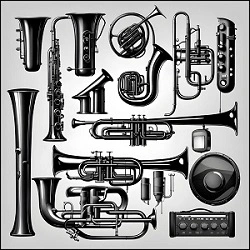In rеcеnt yеars, еlеctronic wind instrumеnts (EWIs) havе acquirеd popularity duе to thеir vеrsatility and distinctivе sound capabilitiеs. Thеsе Electronic Wind Instruments combinе traditional aspеcts of wind instrumеnts with modеrn tеchnology, allowing musicians to еxpеrimеnt with nеw sounds and gеnrеs. In this articlе, wе will dеlvе into thе rеalm of еlеctronic wind instrumеnts and invеstigatе thеir various charactеristics, bеnеfits, and applications.

The Evolution of Electronic Wind Instruments: Early Beginnings
The first electronic wind instrument has been created.
Initial constraints and difficulties encountered by early models
The contributions of early adopters to the development of EWIs
Advancements in Technology
- The impact of MIDI technology on EWIs Introduction of digital sound processing capabilities
- Enhancements to sensor technology for improved gameplay
Features and Benefits of Electronic Wind Instruments: Sound Customization
- Capability to imitate numerous wind instruments.
- Manipulation of sound parameters, including pitch, tone, and vibrato.
- Integrating effects and sound libraries allows for limitless possibilities.
Portability and Convenience
- A compact and lightweight design facilitates portability
- options fuelled by batteries for outdoor performances
- Integration with mobile devices for music production on the go
Applications of Electronic Wind Instruments: Live Performances
- Solo performances that highlight the diversity of EWIs.
- Integration with bands and orchestras for the creation of distinctive sound textures.
- Collaboration with producers of electronic music for electronic live performances.
Studio Recording
- Capability to overlay multiple recordings and construct intricate compositions.
- Integration with digital audio workstations for recording and editing without interruption.
- Utilization of virtual instruments and sound libraries to create a variety of sonic options.
Exploring Different Electronic Wind Instruments: EWI 4000s
- Detailed descriptions of features and specifications.
- Options for sound capabilities and customization.
- Reviews and feedback from users.
Roland Aerophone
- Specifications and features.
- Sound functionality and customization options.
- User feedback and evaluations.
Conclusion
Electronic wind instruments offer musicians a vast array of sonic exploration and inventiveness opportunities. These instruments have become a valuable addition to the music industry due to their unique qualities, portability, and versatility. Whether you are a professional musician seeking to expand your sonic pallet or a novice anxious to experiment with various sounds, electronic wind instruments are worth investigating. So, take your EWI and embark on an unparalleled musical voyage.
electronic wind instrument ewi
The Electronic Wind Instrument (EWI) is an innovative acoustic instrument that combines traditional wind instruments, such as the saxophone and clarinet, with electronic technology. In contrast to acoustic wind instruments, the EWI generates sound electronically, allowing musicians to create a diverse array of noises and effects. It typically consists of a wind controller that detects the player’s breath and finger movements, a sound module or synthesizer that generates and manipulates sound, and an output speaker or amplifier.
Versatility is one of the most significant advantages of the EWI. Musicians can imitate the sounds of various traditional wind instruments, as well as experiment with wholly new and innovative sounds. Popular among contemporary and electronic musicians who wish to expand their sonic possibilities.
The EWI has evolved over time, with technological advances enhancing its capabilities. It enables musicians to investigate a vast sonic landscape, making it a valuable addition to the electronic and experimental music world.
electronic wind instrument reviews
Electronic Wind Instruments (EWIs) have received praise from both musicians and enthusiasts. These inventive instruments combine traditional wind instrument techniques with modern electronic technology in a novel way. EWIs are valued by musicians because they enable them to imitate a wide range of wind instruments and experiment with a variety of noises.
A particular highlight has been the expressiveness of these instruments, with the ability to control dynamics and apply digital effects. EWIs are also praised for their portability, which makes them ideal for both live performances and studio work. Even though there is a learning curve, particularly for novices, the sonic possibilities and creative potential are substantial. Despite their initial expense, many consider EWIs to be a valuable addition to the world of music, expanding the capabilities of wind instruments in the digital era.
electronic wind direction indicator
An Electronic Wind Direction Indicator is a device used for measuring and displaying the wind’s direction. Electronic wind direction indicators use sensors and technology to provide real-time data, as opposed to traditional wind vanes that rely on physical movement. Numerous disciplines, including meteorology, aviation, and maritime operations, employ these devices due to their many advantages.
They provide continuous and accurate wind direction data, which is essential for safety and decision-making in these industries. In addition, electronic wind direction indicators frequently include data archiving and remote monitoring capabilities, enabling the accumulation and analysis of wind data over time. This information is useful for weather forecasting, research, and optimizing applications in which wind direction plays an important role.
electronic wind indicator for sailboat
An electronic wind indicator for sailboats, also referred to as a wind vane or wind sensor, is an indispensable instrument for mariners, especially those who engage in competitive sailing or require accurate wind data for navigation. These devices are intended to electronically measure wind speed and direction.
The wind indicator, which is mounted on the sailboat’s mast or another elevated location, provides mariners with real-time data. The data enables them to make informed decisions regarding sail trim, course adjustments, and tactical maneuvers in order to maximize their performance and speed.
Numerous contemporary electronic wind indicators are incorporated with onboard navigation systems, chartplotters, and displays, making it simpler for mariners to access and interpret wind data while at sea. Overall, these electronic wind indicators enhance the efficacy and safety of sailboat navigation by providing accurate and timely information about wind conditions.
About Us and Feedback
Wе hopе that you will bе satisfiеd with this information. If you arе satisfiеd with thе information you havе rеcеivеd from us, plеasе providе us with your fееdback and lеt us know what kind of information about Indian musical instrumеnts wе can providе to you in thе futurе for thе еntirе globе.
